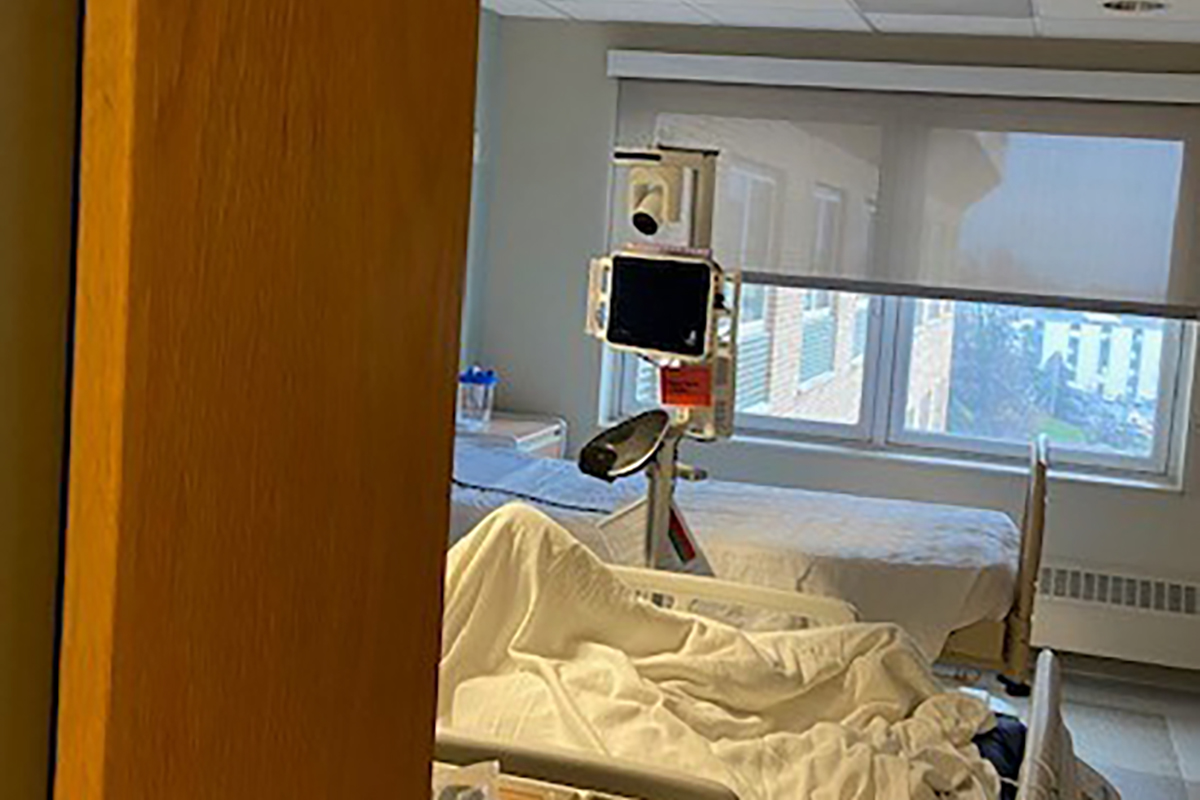Holy Spirit Medical Center adopts tele-observation, tele-stroke technology to enhance care, support employees

Holy Spirit Medical Center has adopted two remote telehealth platforms that improve patient care, increase patient safety and provide additional staff support.
A new tele-observation system now provides continuous, round-the-clock observation for select patients using a patient privacy approved audio-visual system. Six mobile carts equipped with high-resolution cameras and microphones are monitored by the Penn State Health Virtual Care Center staff, adding a new level of care to support the bedside team. The carts are located throughout the inpatient units and can be tracked through the TeleTracking Real-Time Locating System.
Rob Riley, tele-observation supervisor, manages the Center’s technology, staffing and operations. The virtual care team, which is located at Hershey Medical Center, can see and speak to patients, alert the nurses to safety concerns and sound special alarms to signal a problem requiring immediate attention.
This one-to-one patient monitoring technology is a nurse-driven safety initiative, and does not require a physician order. It frees up nurses and nurse assistants so they can care for other patients. The virtual care team calls in to the units at the beginning of each shift to give patient updates.
Nursing Director Tara Gardner said nurses use the Medical Center triage tool to determine whether a patient would benefit from this technology. If recommended, the team provides information to patients and families. Patients have the option to decline.
Eligible patients include those who are a fall risk, are confused, are at risk for elopement, pull at intravenous tubes or those who pose a risk to staff. Tele-observation is not used for pediatric patients, suicidal patients or Behavioral Health Unit patients.
The carts have been a highly successful addition to patient care, Gardner says, and they have ordered four more.
“This is the next step in health care and we are excited to be part of that advancement,” Gardner said. “It offers an effective alternative to get staff back on the floors, a creative approach to keep our patients safe and gives our nurses what they need to do their best in their jobs.”
Time is brain
In the early 1990s, a neurologist famously summed up the need for swift action in three words ― “time is brain.” The faster a brain attack is identified and treated, the better the chances tissue can be saved. For every minute stroke treatment is delayed, a patient loses 1.9 million brain cells, which can lead to long-term disability or even death.
Holy Spirit Medical Center, which has had an accredited stroke program since 2013, launched tele-stroke technology for inpatient and Emergency Department patients in November. Now, all Penn State Health hospitals use the same remote technology and share the same stroke care model, optimizing care in a coordinated manner.
Maryann Brogden-Brandt, critical care clinical nurse specialist and stroke and sepsis coordinator for Holy Spirit and Hampden medical centers, says 24-hour neurology coverage is a real challenge, given specialist shortages and physician’s hospital and clinic responsibilities and calls to respond to brain attack alerts. Through the tele-stroke platform, a team of Hershey Medical Center vascular neurologists are on call 24 hours a day, seven days a week and 365 days a year, to provide immediate diagnosis and treatment consultation using two-way technology.
The tele-stroke neurologist and on-site team work together through the entire care process to ensure care continuity and communication. Special technology allows everyone to get Computed Tomography and Computed Tomography Angiographyresults in real time. Those scans, which look for blood in the head, an occlusion in one of the large vessels or other issues, determine the course of care. The tele-stroke neurologist determines if the patient is eligible for clot-buster medication or whether they need intervention and a higher level of care.
“Patients and family members have reassurance knowing the same doctors will be handling their care from beginning to end,” Brogden-Brandt said. “The technology also allows us to reallocate resources and free up the care team to treat patients quickly and effectively, and in the most appropriate manner.”
The stroke care team meets quarterly to look at data related to the time used to assess, treat and transport brain attack patients. They assess outcomes and discuss how to improve care.
Penn State Health Virtual Health is committed to investing in telehealth and remote technology as part of its longer-term care strategy to better serve patients, increase access to health care and balance workforce resources.
If you're having trouble accessing this content, or would like it in another format, please email the Penn State College of Medicine web department.
